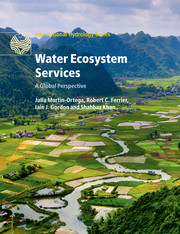Book contents
- Frontmatter
- Contents
- List of contributors
- Preface
- 1 Introduction
- 2 What defines ecosystem services-based approaches?
- Part I Addressing global challenges
- 3 Assessing climate change risks and prioritising adaptation options using a water ecosystem services-based approach
- 4 Operationalizing an ecosystem services-based approach for managing river biodiversity
- 5 Water for agriculture and energy: the African quest under the lenses of an ecosystem services-based approach
- Part II Applying frameworks for water management and biodiversity conservation under an ecosystem services-based approach
- Part III Assessing water ecosystem services
- Part IV Broadening the perspective
- Index
- Plate Section
- References
3 - Assessing climate change risks and prioritising adaptation options using a water ecosystem services-based approach
from Part I - Addressing global challenges
Published online by Cambridge University Press: 05 May 2015
- Frontmatter
- Contents
- List of contributors
- Preface
- 1 Introduction
- 2 What defines ecosystem services-based approaches?
- Part I Addressing global challenges
- 3 Assessing climate change risks and prioritising adaptation options using a water ecosystem services-based approach
- 4 Operationalizing an ecosystem services-based approach for managing river biodiversity
- 5 Water for agriculture and energy: the African quest under the lenses of an ecosystem services-based approach
- Part II Applying frameworks for water management and biodiversity conservation under an ecosystem services-based approach
- Part III Assessing water ecosystem services
- Part IV Broadening the perspective
- Index
- Plate Section
- References
Summary
3.1 INTRODUCTION
Climate change poses a significant threat to the capacity of the world's freshwater ecosystems to provide critical water ecosystem services upon which both human and non-human systems rely (Bates et al. 2008). High degrees of exposure and sensitivity to climate change effects, amplified by the position of freshwater ecosystems in the landscape and constraints on their adaptive capacity due to intensive human use and modification, imply a high level of vulnerability among freshwater ecosystems to climate change (Vörösmarty et al. 2010; Capon et al. 2013). Rising temperatures, sea-level rise, and changes to the hydrologic cycle are all expected to alter the distribution and extent of goods and services supplied by freshwater ecosystems (Palmer et al. 2009). At the same time, dramatic increases in human demands for water ecosystem services, particularly provisioning services (e.g. water supplies for irrigation), are widely anticipated (UNESCO 2012; Salman and Martinez, this book). The importance of many regulating and supporting ecosystem services (e.g. water purification) for both human and non-human needs are also likely to grow under a changing climate (Capon et al. 2013). Indeed, the role of some water ecosystems services can be anticipated to become increasingly critical in relation to climate change mitigation (e.g. climate regulation) and adaptation (e.g. flood control). Effective human responses to climate change must therefore be underpinned by an understanding of climate change risks to water ecosystem services and options for their protection, restoration, or enhancement.
In this chapter we propose an ecosystem services-based approach to climate change adaptation to enable an integrated assessment of climate change risks that accounts for both human and non-human systems, as well as their interactions. Adopting ecosystem services as targets for managed adaptation can guide the prioritisation of adaptation measures so that low-regret options with multiple benefits are highlighted and perverse outcomes avoided. An ecosystem services-based approach also offers a basis for communication and education to engender public and political engagement in climate change adaptation decision-making.
- Type
- Chapter
- Information
- Water Ecosystem ServicesA Global Perspective, pp. 17 - 25Publisher: Cambridge University PressPrint publication year: 2015
References
- 11
- Cited by

